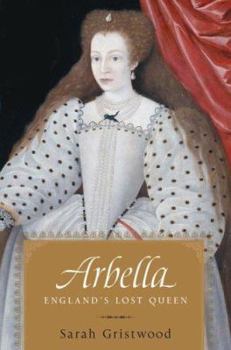Arbella: England's Lost Queen
Select Format
Select Condition 
Book Overview
'It is Arbella they would proclaim Queen if her mistress should happen to die' Sir William Stanley, 1592 Niece to Mary, Queen of Scots, granddaughter to the great Tudor dynast Bess of Hardwick, Lady... This description may be from another edition of this product.
Format:Hardcover
Language:English
ISBN:0618341331
ISBN13:9780618341337
Release Date:January 2005
Publisher:Houghton Mifflin
Length:450 Pages
Weight:1.77 lbs.
Dimensions:1.5" x 6.3" x 9.4"
Customer Reviews
2 ratings
Now I have lost all I can lose or almost care to lose.
Published by Thriftbooks.com User , 16 years ago
Arbella England's Lost Queen is the story of Arbella Stuart, the presumed heir to the throne after Queen Elizabeth I. Sarah Gristwood meticulously traced Arbella's life from infancy through her last tragic moments. Arbella was groomed to be Queen Elizabeth's heir by her Grandmother, Bess of Hardwick. Elizabeth never declared Arbella her heir, but implied so on various ocassions. Therefore, Arbella grew up thinking she was destined for greatness, but her reality was something much different. As the years passed and Arbella's patience grew thin, Arbella found herself cast aside and all but forgetten in her Grandmother's home of Hardwick. Arbella's "Hardwick Days" were the most fascinating to me. One can only imagine the desperation of this amazing woman. When her dreams of a life outside of Hardwick and marriage seemed a lost cause, Arbella began writing letters, which Sarah Gristwood describes as "bizarre and wonderful documents". These letters, one of which Gristwood states is over seven thousand words long, have caused posterity to question's Arbella'a sanity. The author, however, is not quick to adopt this theory. In Appendix B, Gristwood questions the theory that Arbella's letters were a result of Porphyria, which she calls a "royal malady" since the illness can be linked to various royals, such as George III. Arbella was finally rescued from Hardwick after Queen Elizabeth's death by her cousin the now King James I, however her future circumstances can hardly be called a rescue. The King's paranoia kept him from approving a marriage for Arbella, who he feared could present a threat to his claim to the throne. Arbella, however, took matters in her own hands when she married William Seymour. The marriage of two of such royal blood sent the King into a frenzy. William was thrown into the tower, and Arbella was banished from court. The couple soon plotted an escape abroad, William's escape was sucessful, but Arbella was not as lucky. Arbella was imprisoned in the Tower, where she stayed until her death. This book is definitely a keeper. The author took an obscure historical figure and transformed her story into a tale of very complex human being that even twenty first century readers can relate to. The wonderful illustrations of Arbella, Bess of Hardwick, Hardwick hall, among others vividly bring the characters to life. At the end of the book the author shares the news of somewhat recent discovery at Hardwick Hall. In 2003, a leather bound book was discovered in the walls of the Hardwick dining room. Could this book be connected to Arbella Stuart? The evidence linking Arbella to the book is flimsy at best. But Gristwood, eager for a connection to the long forgotten Princess, cleverly pieces together the evidence that allows for the possibility of an Arbella connection.
A sympathetic treatment of a tragic character
Published by Thriftbooks.com User , 18 years ago
Arbella Stuart is one of the tragic characters of history. Her closeness to the throne of England provided a strong reason for Elizabeth I and her court to imprison her from a very young age. This was an age of potential instability, Mary Queen of Scots had been the centre of many plots and had eventually been executed. Indeed Elizabeth had herself been imprisoned by her sister Mary before ascending to the throne. She had had to walk a very dangerous path to ensure her own survival let alone succeed the throne. And it was not unknown for coups to destabalise the country. Lady Jane Grey and her husband Dudley had been pushed on the throne following Edward I death in 1553 -if only for 9 days. The machinations of Tudor/Stuart politics did make for sensitive treatment of children if they were political hot potatoes as Arbella was. She was brought up literally by Bess of Hardwick, but as a prisoner, her own parents died when she was young. The problems with knowing about Arbella is much of what can be researched is secondary, or social. Arbella is mostly known personally from her letters of 2003 - and they demonstrate a woman driven possibly made - although there is the possibility that she, like the later stuart descendents in the House of Hanover, suffered from Pophyria. Sarah Gristwood writes well and Arbella, her life and times does indeed come alive. Gristwood knows her subject well and her times. From her ill-fated birth to her tragic death from starvation while still relatively young. I was reminded in some parts of the lives some 200 years later of the daughters of George III - they too were prevented from living their own lives but in slightly different circumstances, but their one ambition was to marry - and in the end that is all Arbella really wanted, to marry and be free. A sad but sympathetic study of one of history's tragic has-beens.






